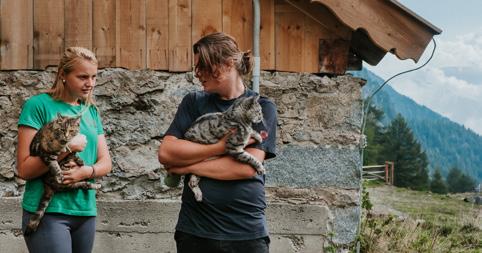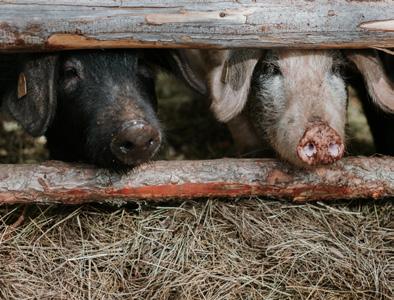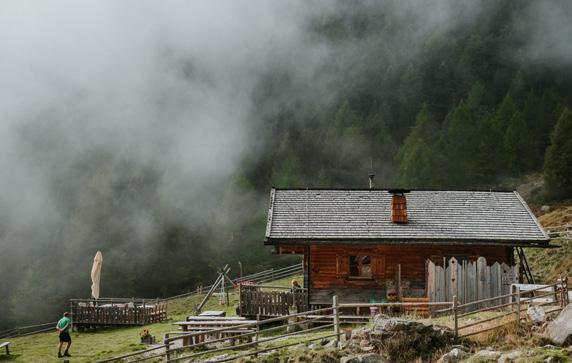
9 minute read
The People up There Family life at an Alpine hut and pasture
The
People
Advertisement
up There
Bernhard Mulser is a herder at the Zirmait Alpine pasture, high above Bressanone/ Brixen. With his wife and two children, he cares for the cattle and pigs, the four of them living in isolation on the mountain for months. Read on to find out how life in an Alpine hut affects a family.

Text — MATTHIAS MAYR Photos — MICHAEL PEZZEI
N
o, the “Zirmait-Alm” is not an overcrowded Alpine hut with tawdry tablecloths and service staff in lederhosen and dirndl dresses. This Alpine hut is for real. Here, far from the hustle and bustle of the valley, life is still quaint and authentic. Calves are grazing on the steep slopes of the pasture; pigs are wallowing in the mud. Hungry hikers are treated to a home-cooked meal prepared on a wood-burning stove.
In this place, Bernhard Mulser has just spent his first summer as a herder, together with his family. “From early June to late September, we’re up on Zirmait every day—and we’re up and about all day, from sunrise to sunset”, he says. Can this really work, or are arguments the daily fare of family life? Does the constant proximity of everyone result in cabin fever? How is life up there affecting everyone? How does your own perception change? Your way of thinking? Of feeling?
The Mulser family is from Fiè allo Sciliar/Völs am Schlern, 35 kilometres to the south of Bressanone. The father, Bernhard, is a self-employed joiner; the mother, Bernadette, is a sales clerk. Their son Klaus, seventeen, is looking for an apprenticeship as a gardener; Lisa, their twenty-one-year-old daughter, went to art school in Val Gardena/Gröden and is now looking to study psychology and art. We’re visiting them during their last summer days up on Zirmait. The four of them are satisfied when looking back on the past few weeks—although summer can be taxing; the days at the Alpine hut and pasture are long and exhausting.
The Mulser family was looking to do something different. Other families would simply go away on a weekend trip; they
took a radical step, leaving their everyday lives and jobs behind, and trying something entirely new.
Bernhard Mulser and his son Klaus are in charge of the cattle. Fifteen calves between 18 months and two years old are spending the summer on the mountain pasture. The Tyrolean Grey cattle, a typical breed in the region, are full of curiosity. They yield both good milk and good meat, and their favourable feed conversion ratio and sure-footedness make them ideally suited for pastoral farming. Apart from the cattle, the Mulser family also keeps three Tyrolean Alpine pigs, an old breed. The pigs mature slowly, but their meat is of high quality and low in cholesterol. They are free to feed on hay, apples, and other delicacies. The population of the Zirmait pasture further includes a donkey, a horse, and a pony—and the family has brought their pets, Parson Russell terrier Kiwi and the cats Furbi and Kitti, to spend the summer. The cats hide out of sight, the dog wants to play.
“I learned to handle animals as a child on my parents’ farm and later as a herder”, says the father. He has acquired knowledge which he deepens on a daily basis. “You’ve got to be a jack-of-all-trades at an Alpine hut”, he continues. “A herder, a craftsman, a meteorologist, a veterinarian, and a tour guide.” His daughter Lisa has already worked two summers as a waitress at a mountain hut, but working at a small Alpine hut and pasture is even more extraordinary than that. She is not only a waitress, but also a cook, a herder, a craftswoman, and a farmer. Taxing and

The ZirmaitAlm
The Zirmait Alpine hut is located just below the Karspitze peak in easy reach from Varna/Vahrn, Spelonca/Spiluck, or Scaleres/ Schalders. It takes about an hour and a half to hike from the hut to the summit, and the ascent is not particularly difficult. The panoramic view of the surrounding mountains and valleys from the top is stunning.


Parson Russell terrier Kiwi and the two cats Furbi and Kitti are spending the summer at the Alpine hut and pasture together with their family.


Apart from grey cattle, a donkey, a horse, and a pony, the Mulser family also keeps Tyrolean Alpine pigs—an old breed.


“We’re all really spoiled down in the valley”, says Bernhard. “Up here, you accept everything as it is, and try to make the best of it.”
pleasant: that is the Mulser family’s summer in a nutshell. Long and hard days, but also a break from everyday routine, and a new experience. “This is not austerity, this is real life”, says Bernhard. “I have everything I need up here”, adds his son, Klaus.
The Zirmait pasture is situated at 1,891 metres above sea level. It can be reached in approximately two and a half hours on foot from the village of Varna/ Vahrn north of Bressanone, or in 45 minutes from the car park at the end of the road. It offers a sweeping, open view of the Plose and Plan de Corones/Kronplatz mountains, the craggy peaks of the Gruppo delle Odle/Geisler, even the Zillertal Alps. The hut is off the beaten track, catering to locals rather than tourists. Hikers who stop here are usually on their way to the 2,517-metre-high Karspitze peak, another one and a half hours’ hike.
Mother Bernadette and daughter Lisa are tasked with cooking. The wood-burning stove in the small kitchen is stacked with pots and pans and is radiating a pleasant heat. Goulash and vegetable soup are simmering happily, and the room is filled with the garlicky smell of the tomato sauce for the Zirmait pasta. Bernadette has a huge bowl of dumpling dough in front of her, deftly rolling the “national dish” of South Tyrol. She is also a pas

sionate cake baker and always has several types in stock. Bernhard complements the culinary experience with his home-made spirits.
Time passes at its own pace up here. The sun determines when the work starts and when it ends, and there is more than enough work to go around. But still the family does not seem stressed. “You just have to take your time”, says Bernhard. The four Mulsers are enjoying the luxury of leading a self-determined life at one with nature. But still: life at the Alpine hut is an adventure. A photovoltaic system supplies the hut with power, with eight truck batteries for buffer. That system will provide a maximum output of 3.5 megawatts—if the sun shines. Bad weather means saving electricity, so that the fridge and freezer can do their jobs. A spring provides fresh water, but that must be used sparingly, too: the great drought last summer left the Alpine hut with a minimal water supply for weeks. It makes everything a bit more difficult, but it’s not the end of the world, says Bernhard. “Down in the valley, we’re all really spoiled. Up here, you accept everything as it is, and try to make the best of it.”
There are a small sun terrace and a swing set for children in front of the Alpine hut, and a little herb garden. They are trying to grow as much as they can
Time passes at its own pace up here. The working routine is determined by the sun. And there is more than enough work to go around.
→ Bernadette is a passionate cake baker. Together with her daughter Lisa she keeps everyone fed.


Family life has benefited from the summer up in the mountains. “This experience has brought us all closer together”, says Bernhard Mulser.


Many tasks up in the mountains require a group effort—even making lingonberry preserves.
Mobile phone reception is patchy at best up here. All you hear are cowbells and the occasional crow.
themselves: back to the roots, literally. The house itself is small: apart from the kitchen, there’s the dining room open to the public, a room for the parents, and a small toilet—nowadays, the outhouse by the stables is only there for show. “Any guests who stop by spontaneously and stay the night are put up in a dormitory in the attic”, says Klaus. He and his sister do not sleep in the hut, however—they sleep in the stables. As the calves do not need the stables in summer, they are serving as storage space, and two rooms have been set up for the children.
It’s very quiet at Zirmait. The family is even forced to go without mobile phones most of the time; reception is patchy and poor at best up here. All you hear are cowbells and the occasional crow. Of course, the family is not completely cut off from the rest of the world. It’s a half hour’s car ride to Bressanone, be it in the jeep or in the traditional car of South Tyrolean mountain people: the Fiat Panda. But they feel very, very far removed from city life. So far that they don’t even miss it. The Mulsers regularly argue about who has to drive down into the valley to do the shopping.
Family life has benefited from the summer up in the mountains, at any rate. “This experience has brought us all closer together”, says Bernhard Mulser. And that is not necessarily guaranteed when you constantly hang around each other for four months. “You get to know your family better”, says daughter Lisa in agreement. They start their mornings by having breakfast together, talking about the day and scheduling the tasks: where are the calves, what are they going to cook today, is there enough power for the oven, who is fetching the firewood? None of these decisions are earth-shattering, but up here in the hut, they are essential for survival. Down in the valley, everyone goes their own way, but up here, many tasks must be completed together. And in spite of all the challenges, there has never been a major falling-out. “We’re still getting along”, says Klaus happily.
Now, in late August, the weather has cooled down noticeably on Zirmait. There will still be many warm and sunny autumn days, but at these altitudes there is even the possibility of snow in September. The family is looking back on a successful summer, but soon it will be time to bid farewell to Alpine life. The Mulsers are already wistful about returning to the valley. “We definitely want to come back next year”, says Bernadette. And thus the thought of the next Alpine summer eases the pain of parting.










